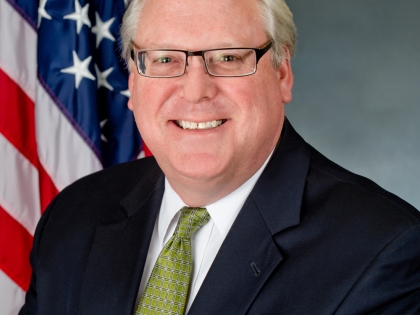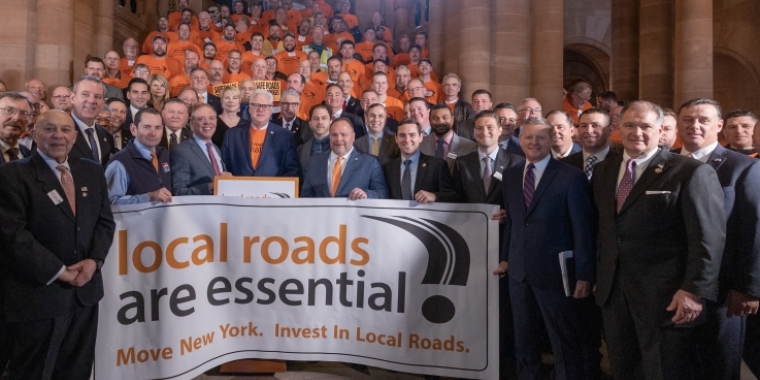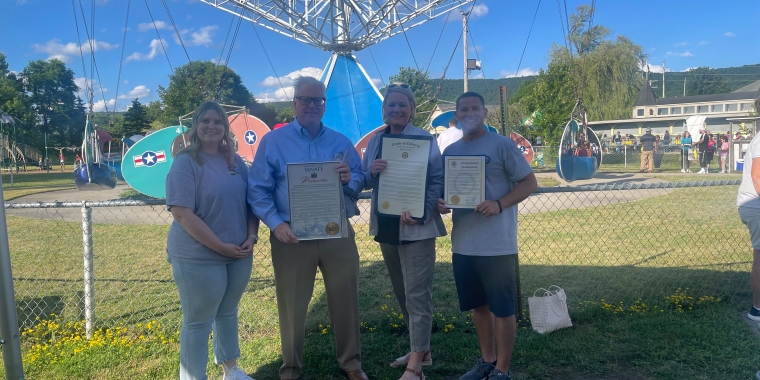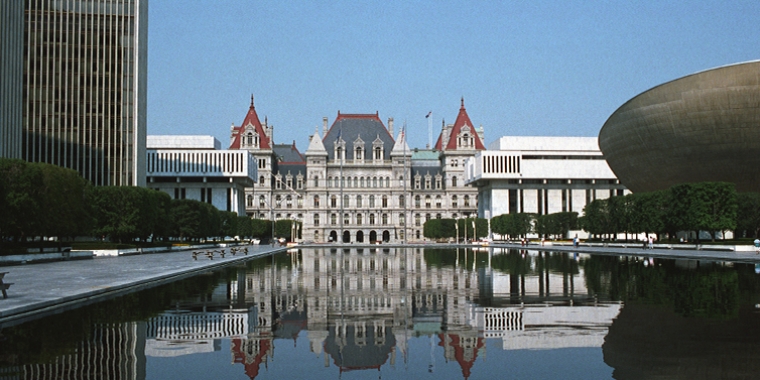
‘Local Roads Are Essential’ coalition: Local roads and bridges across NY deserve stronger state commitment
March 8, 2023
-
ISSUE:
- local roads and bridges

Albany, N.Y., March 8—State Senator Tom O’Mara (R,C,I-Big Flats), Assemblyman Phil Palmesano (R,C,I-Corning), and more than 70 state Senators and members of the Assembly today joined county and town highway superintendents and other local leaders from throughout New York calling for increased state support for local roads, bridges, and culverts.
The group held a news conference at the Capitol this morning and were joined by Senate Republican Leader Rob Ortt (R,C,I-North Tonawanda) and Assembly Republican Leader Will Barclay (R,C,I-Pulaski).
Hundreds of local transportation advocates from throughout the state are in Albany this week for their annual “Local Roads Are Essential” advocacy campaign sponsored by the New York State Association of County Highway Superintendents (NYSCHSA) and the New York State Association of Town Superintendents of Highways, Inc. (NYSAOTSOH).
They are once again fighting for greater state investment in New York’s local transportation infrastructure. Since 2013, O’Mara and Palmesano have organized legislative colleagues to get behind the effort and raise awareness of the need.
The coalition notes that over the past decade, largely through a series of “Extreme Winter Recovery” (EWR) allocations distributed through the state’s Consolidated Local Street and Highway Improvement Program (CHIPS) funding formula, the PAVE-NY and BRIDGE-NY programs established in 2016, and last year’s “Pave Our Potholes” (POP) initiative, important increased state support has been provided for New York’s counties, cities, towns, and villages.
This year, the legislators note that while Governor Kathy Hochul’s proposed 2023-2024 Executive Budget calls for the continuation of the state’s key local roads programs, including CHIPS, EWR, PAVE-NY, the State Touring Routes Program (STR) and POP, the proposal holds funding for each of these programs at current levels. They charge that Hochul has failed to recognize the impact of a 22% construction inflation rate and how the exorbitant, inflationary cost increases for fuel, asphalt, and steel that are severely straining county and town transportation budgets.
In a March 7, 2023 letter to Hochul and legislative leaders, O’Mara, Palmesano, and their Senate and Assembly colleagues wrote, “We believe that New York State's investment in local transportation infrastructure must be a foundation of the nation's most aggressive infrastructure program in order for this program to achieve its envisioned generational goals. Unfortunately, the Executive Budget proposes local road, bridge, and culvert funding to remain flat for this second year of the five-year, Department of Transportation (DOT) Capital Plan. First and foremost, in our view, the Governor’s proposal fails to recognize or understand the impact of a 22% construction inflation rate. For example, New York State Department of Transportation’s July 2020 to July 2022 price adjustments show significant cost increases. Fuel costs are nearly 260% higher, asphalt nearly 80% higher, and steel costs have increased by approximately 115%.”
[see attached copy of the letter above]
While welcoming the governor’s commitment to infrastructure investment in the new state budget, the Local Roads Are Essential advocates are calling on New York to strengthen support for local transportation beyond Hochul’s proposals by the following actions:
1.) Increase the base funding level for CHIPS by $200 million to a total of $738 million;
2.) Increase Extreme WinterRecovery funding by $70 millionto $170 million;
3.) Increase the CHIPS bidding threshold from $350,000 to $750,000; and
4.) Restore the Dedicated Highway and Bridge Trust Fund (DHBTF) to its originally intended purpose as a dedicated, pay-as-you-go funding source for critical transportation repairs and capital projects.
In a joint statement, O’Mara and Palmesano said, “We have long stood with New York’s county and town highway superintendents, and local leaders, in support of stronger state investment in our local transportation infrastructure. We continue to believe this commitment is a fundamental responsibility and critical to the strength and success of local communities, economies, environments, governments, and taxpayers. We will always do everything we can to raise our voices, raise awareness, and raise support for the local roads and bridges that are essential to New York’s future.”
[Watch Senator O'Mara's opening remarks at today's news conference HERE, and watch the full news conference HERE.]
Senate Republican Leader Ortt said, “Local roads and bridges are essential to the vitality of New York. But even more important are those local highway department employees who are out there every day making sure roads are paved and plowed safely for pedestrians and motorists. It is important that we continue to dedicate state funding for programs such as CHIPS and EWR in this year’s state budget, and I will continue to strongly support these essential critical infrastructure investments.”
Assembly Republican Leader Barclay said, “Aging infrastructure strains nearly every segment of the economy. Commuters, emergency service personnel and small businesses cannot afford to be hamstrung by inadequate roads, bridges and other important infrastructure considerations. Simply put, adequate federal funding is not reaching our municipalities and they do not have the resources needed to keep their economies running at peak efficiency. Our Conference will continue to fight for our local governments and the funding they need, and I am hopeful this year’s budget will include the proper financial commitment that towns and villages require to grow.”
Among other studies, an October 2017 report from State Comptroller Thomas DiNapoli estimated that locally owned bridges alone need at least $27.4 billion in repairs. An earlier report from the comptroller called 32% of New York’s local bridges deficient and 40% of local roads fair or poor, and getting worse.
An analysis by the New York State Association of Town Superintendents of Highways found that the local highway system outside of New York City faces an annual funding gap of $1.7 billion.
According to TRIP, a national transportation advocacy group, roads and bridges that are deficient, congested, or lack desirable safety features, cost New York motorists an additional $28 billion annually — up to $3,200 per driver in some areas — due to higher vehicle operating costs, traffic accidents, and congestion-related delays.
Kevin Rooney P.E., President of the New York State County Highway Superintendents Association, said, “Construction inflation means less work will get done. Our dollars won’t go as far meaning fewer critical projects will be completed and more will be delayed. Less work for our contractors means fewer construction jobs and likewise fewer contracts for MWBE firms. Our equipment and materials suppliers will try to recover their inflationary cost through higher prices. Delays in highway and bridge maintenance means more costly rehabilitation and reconstruction down the road. State funding needs to be increased to avoid the worst impacts of the unprecedented construction inflation on our already aging and ailing local transportation systems.”
Dave Miller, President of the New York State Association of Town Superintendents of Highways, and Highway Superintendent for the Town of Lockport said, “On behalf of the more than 900 Town Highway Departments represented by NYSAOTSOH, I make an urgent appeal to the Legislature to expand the state’s commitment to local highways and bridges beyond what is included in the Governor’s Executive proposal. Record high inflation has reduced our buying power by nearly 25%, which amounts to a disastrous cut to the funding necessary to maintain safe roads and bridges. We need another $270 million added to the Governor’s plan for local highway programs such as CHIPS and EWR just to hold our ground dollar for dollar with the current year allocation. The implications are considerable given that 87% of roads and more than half of the bridges in New York are locally maintained, with just a small fraction of those eligible for federal funding. If the state does not step up and add to the Governor’s plan, we can anticipate a potentially crippling erosion of our transportation infrastructure.”
Stephen J. Acquario, Executive Director of the New York State Association of Counties (NYSAC), said, “NYSAC stands with our county highway superintendents who work hard each and every day to plow and pave local roads and bridges. Every highway department relies on CHIPS funding to construct and maintain the roads that our families, businesses and first responders rely on. As melting snow gives way to major potholes and disrepair, and as inflation drives up the cost of materials and labor, it is more important than ever for State Lawmakers to invest in the CHIPs program so our highway departments have the resources they need to keep local roads safe and smooth. Counties commend Assemblyman Phil Palmesano and Senator Tom O’Mara for their leadership and enduring commitment to local infrastructure investment”.
Peter A. Baynes, Executive Director of the New York State Conference of Mayors and Municipal Officials (NYCOM), said, “New York's local road and bridge infrastructure is the backbone of our state’s economy and, as such, needs a growing investment from our state government. This is why NYCOM strongly supports the legislative effort to increase the appropriation for the CHIPS and Extreme Winter Recovery local highway aid programs. This aid will produce tangible and essential results for all New Yorkers.”
Gerry Geist, Executive Director of the Association of Towns of the State of New York, said, “The single best way to support local roads and bridges is by increasing the CHIPS base. Safe and well-maintained roads are critical to New York’s livelihood, and we hope to see a much-needed increase in funding in final state budget.”
Renee St. Jacques, New York Farm Bureau Associate Director of Public Policy, said, "A strong food chain depends on reliable infrastructure. New York's farmers need safe roads and bridges to transport goods to market and to travel between farm fields, including during critical planting and harvest seasons. New York Farm Bureau supports the continued investment into the CHIPS program to benefit rural and urban communities across the state, and we thank the coalition of lawmakers for their ongoing support.’
Michael J. Elmendorf, President and CEO of the Associated General Contractors of New York State (AGC NYS), New York’s leading statewide construction industry organization said, “Washington created a once in a generation opportunity for New York to truly rebuild when it passed Bipartisan Infrastructure Bill—which delivered an historic 52% increase in federal funding for New York’s roads and bridges over 5 years--$4.6 billion more. Unfortunately, as Washington stepped up, New York stepped back and grew the NYSDOT Capital Plan by only $2 billion over the same 5 year period. And now, massive inflation and construction material cost escalation have more than consumed that modest growth. Without additional investment in roads and bridges in this year’s budget, we will see worse conditions despite the federal government’s historic action. We cannot allow that to happen—we need to rebuild New York now.”
Fred Hiffa, Rebuild New York Now, said “Record high inflation rates on highway construction materials have severely increased costs and, as a result, reduced the DOT’s core program to its lowest real spending levels since 2015. The other significant issue not addressed in the Executive’s budget is that the Department will need up to an additional $2.2 billion, a potential 50 percent increase, to just deliver the currently programmed signature projects. It is crucial that an additional $1.128 billion be added to the 2023-24 budget for state and local highway construction just to keep funding at the same level it was when the five-year program was initially adopted in 2022.”
Ronald L. Epstein, President and CEO of the New York Construction Materials Association said, “We commend Governor Hochul and Legislative Leaders for securing the first new five-year transportation capital plan in nearly a decade. While the capital plan adopted last year provides a strong foundation from which to build, the current condition of our roads and bridges statewide jeopardizes the system’s reliability and delays achievement of the State’s principal economic development and environmental sustainability goals.”
Marc Herbst, Executive Director, Long Island Contractors Association said, “Last year, the legislature adopted a five-year transportation capital plan, and the Governor’s budget proposal commits to honoring the program’s second-year funding plan. We urge you to be mindful of how devastating inflationary costs have impacted the industry. Today’s bedroom community of Long Island requires support for its highway system upkeep. Our local residential communities benefit significantly from CHIPS, and it is imperative that the NYS Budget increases the funding levels for this program.”
O’Mara and Palmesano concluded, “While we support the MTA, and understand it is the lifeblood of the downstate transportation network, it is equally important to remember that the successful and impactful CHIPS program is the lifeblood of our upstate transportation network. In fact, in some instances, CHIPS is the only funding some municipalities have to fix and improve their local infrastructure. Additionally, it is important to remember the fact that 87% of the roads and 52% of the 18,000 bridges in New York State are owned and maintained by our local municipalities. Although billions of dollars are flowing into New York State from the federal government for infrastructure, the reality is nearly 90% of local roads are ineligible to receive this federal funding. Therefore, it is even more critical that New York State partners with our local municipalities and property taxpayers and increase funding for our local roads, bridges and culverts through the CHIPS and Extreme Winter Recover (EWR) programs.”



